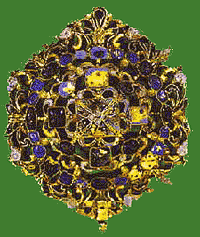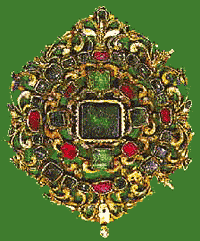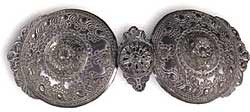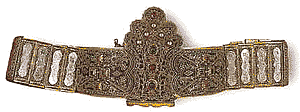  |

|


Fig. 12
Gold double-sided pendant executed in opus interassite
technique and embellished with precious stones and cloisonne
enamel.
Dimensions: 7.9 X 6.4cm. l7th century.
Athens, Byzantine Museum, T 464.
|
|

Fig. 13 Silver
buckle from Philippopolis, with embossed floral decoration.
Dimensions: 12.5 X 8.2cm.
l9th century.
Athens, Byzantine Museum, T 640.
|

Fig. 14 Buckle from Asia Minor. Gilded silver
with perforated reticular decoration and repousse floral motif at the
centre of the two plates and clasp. Dimensions: 31 X 11.5cm.
l9th century.
Athens, Byzantine Museum, T 1548.
|
|

Fig. 15 Gilded silver belt of
articulated plates and integral buckle with floral ornaments in
filigree, glass-paste 'gems' and enamel. Dimensions: 77 X 11.5cm.
1836.
Athens, Byzantine Museum T 1402.
|

Fig. 16 Buckle from Asia Minor, of
gilded silver decorated in filigree and granulation. The double
rosette at the center is set with a large green artificial gem of
glass paste. Dimensions: 9.5 X 7.7cm.
19th century.
Athens, Byzantine Museum T 1566.
|
The imperial and other important workshops of the Capital obviously attracted
the most accomplished artists in the state. In the Queen of Cities, eternal
melting pot of men and ideas, the dominant stylistic tendencies were shaped and
moulded, and from there they diffused, determining likewise in different eras
the structure, types and forms of jewellery in its constant variations and
musical harmonies.
Definitive were the spiritual and artistic roots of the ancient Greeks,
continuous and vital presence in both the Classical and the ecclesiastical
humanistic education, which set their seal on the Byzantines' love of beauty.
After Justinian the intellectuals of the Capital initiated the `renaissances' of
the Macedonian, the Comnenian and the Palaeologan emperors, which were forged
with `nostalgic' recourses to the past and bore fruit in diverse categories of
art, inspiring jewellery too with animating style.
Very few of the masterpieces of Constantinopolitan goldsmithing have survived
of the precious crowns and the other insignia of royal authority, of the
treasures of the imperial palace, the courtiers, the military officers and the
prelates, of the sacristies of Hagia Sophia and the other churches and
monasteries. Those pieces preserved over the centuries, despite times of
economic hardship, were mostly lost during the sack of the world's richest and
most magnificent city, by the Crusaders in 1204 and in the final fall to the
Ottoman Turks in 1453.
Myrtali Acheimastou-Potamianou, Ph D
Director of the Byzantine Museum, Athens
|
|


|
Greece jewellery pages Copyright ©
by Add
Information Systems. (Greece)
|
|
  |

